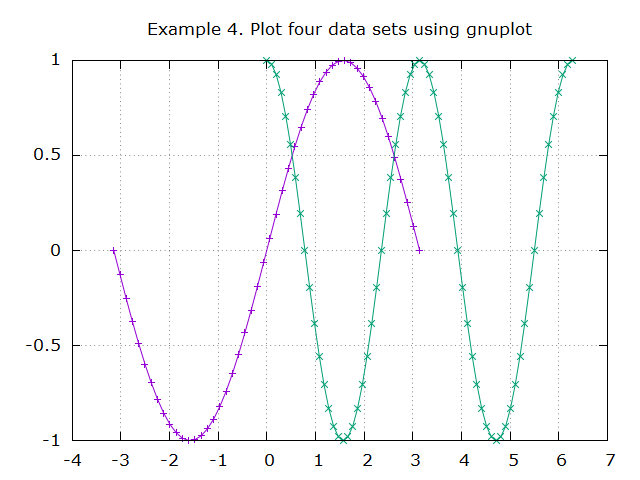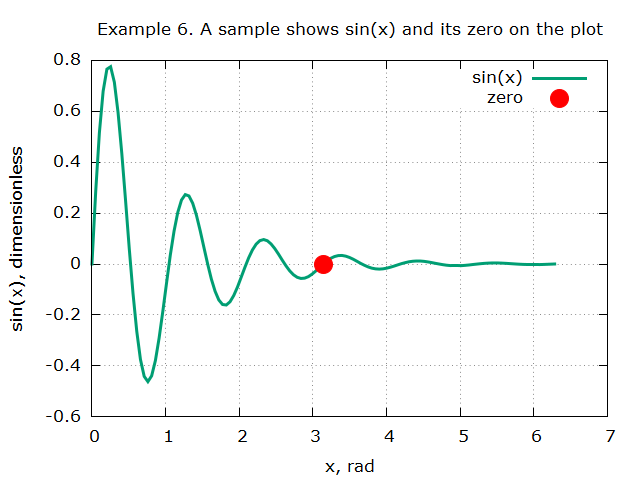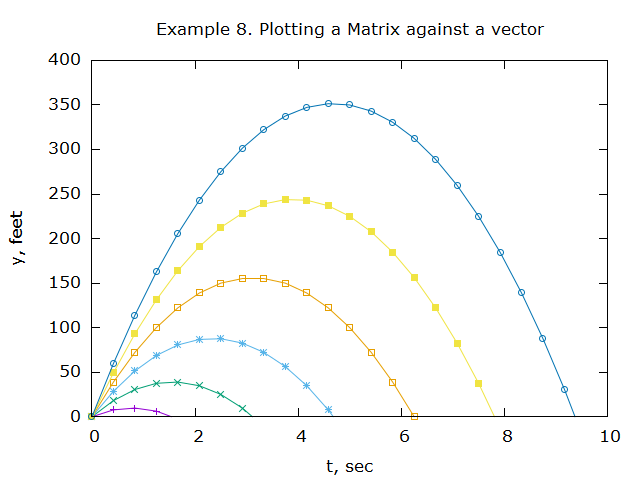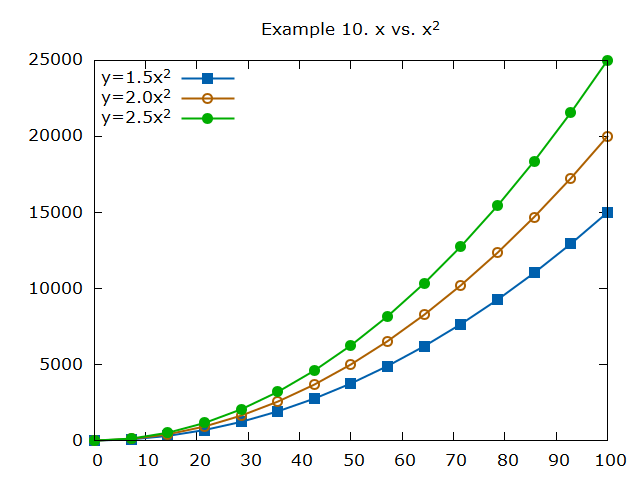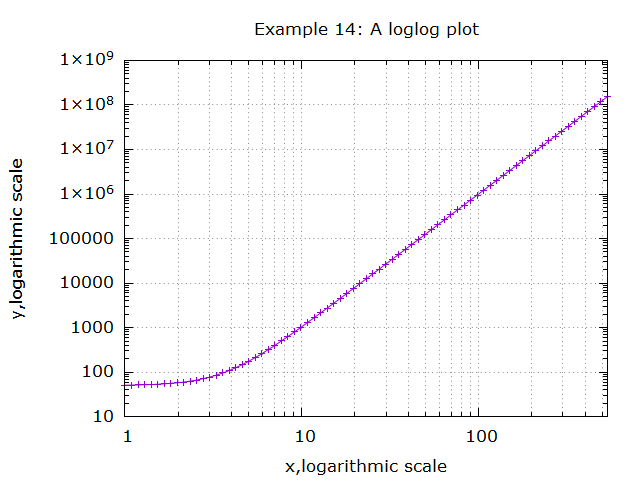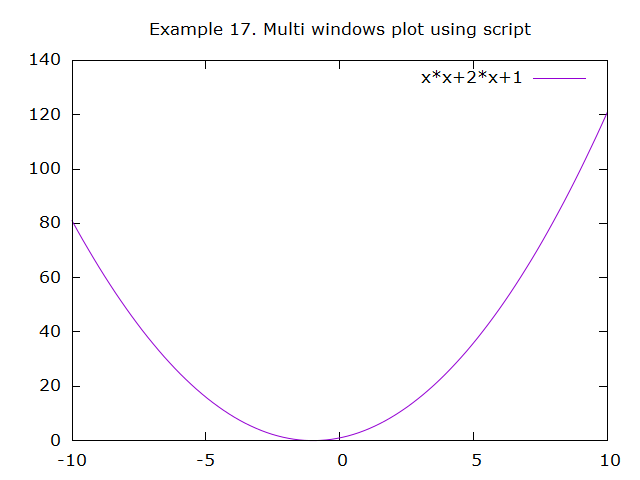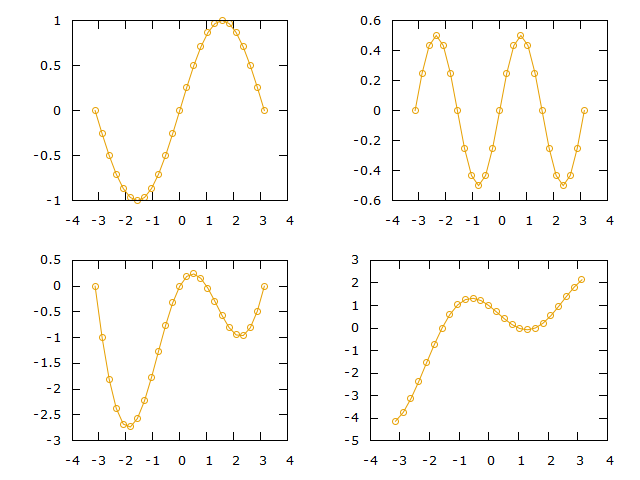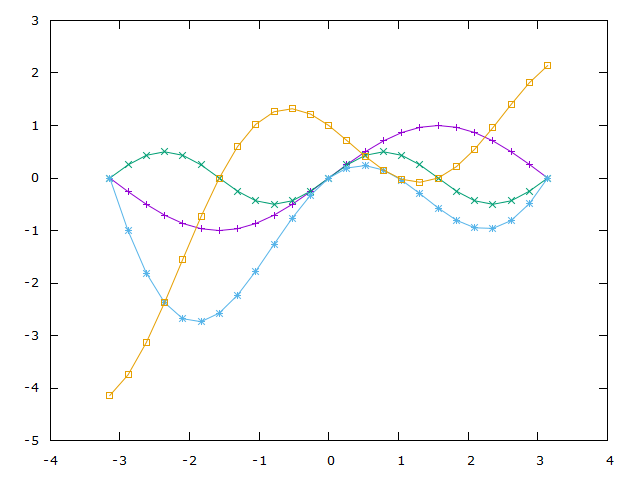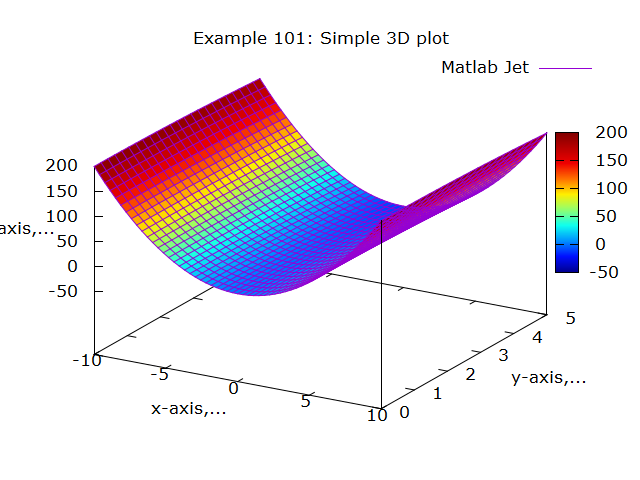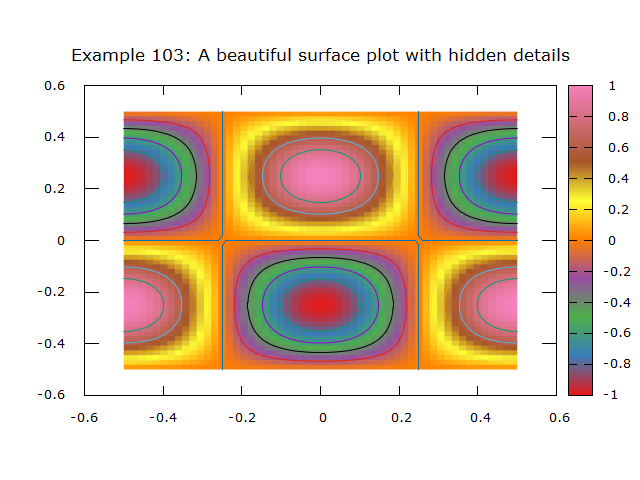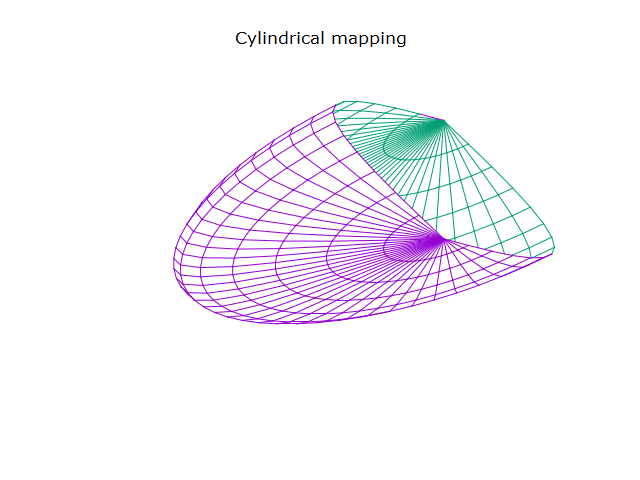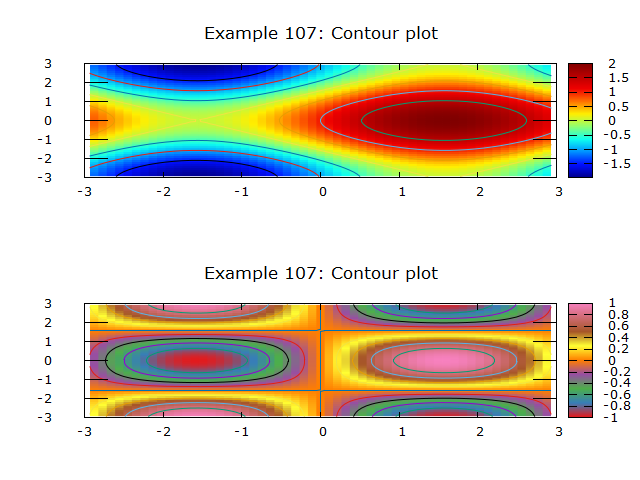Object Based Interface to GnuPlot from Fortran (ogpf)
Prerequisite: gnuplot must be installed on your system.
The ogpf is a zero installation library! Just copy and paste the ogpf.f90 in your project folder or in your library folder and use it! No any further step is required. However if you like to add ogpf to your projects through package managers, builders, installers see below options!
Fortran Package Manager (fpm)
To use ogpf with your fpm project, add the following to your package manifest file (
fpm.toml):[dependencies] ogpf = { git = "https://github.com/kookma/ogpf.git" }You can then
usethe package as normal in your Fortran program withuse ogpf.To run the example program in this package with fpm:
$ git clone https://github.com/kookma/ogpf.git $ cd ogpf $ fpm build $ fpm run --example
Meson Builder
The alternative is through the use of the Meson builder, which is multiplatform and multi source language build system. You can just use the ogpf git repo as a subproject in your own meson project. If you're unfamiliar with it, just read this begginer's guide.
After learning the basics, you can create a folder called subprojects on the root of your project and create a file inside with the following content:
[wrap-git] url=https://github.com/kookma/ogpf revision=headThen on the meson.build file you have to import the subproject and grab the library variable. This is a sample meson.build file:
project('research','fortran') ogpf_proj = subproject('ogpf') ogpf_dep = ogpf_proj.get_variable('ogpf_dep') executable('research', dependencies: ogpf_dep)and all the compiler flags will be handled.
Make sure you have a working version of gnuplot must be installed on your system. Start with provideed examples.
| Simple plot | Animation |
|---|---|
 |
 |
| Surface | Contour |
|---|---|
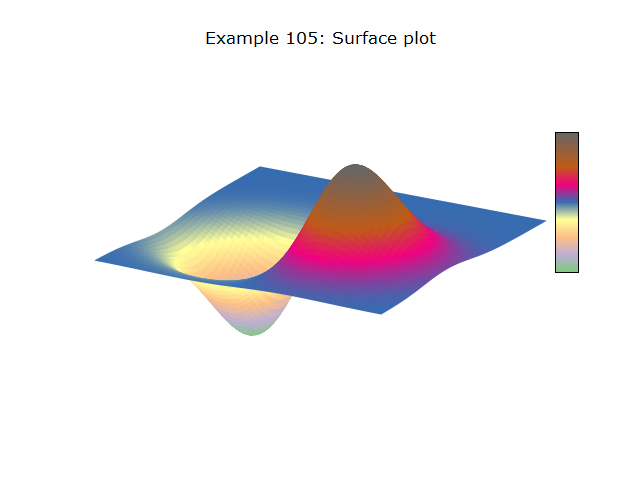 |
 |
Purpose: Object Based Interface to GnuPlot from Fortran (ogpf)
Platform: Windows XP/Vista/7/10, Linux
(It should work on other platforms, e.g Mac see the finalize_plot subroutine in ogpf.f90)
Language: Fortran 2003 and 2008
Requires: 1. Fortran 2003 compiler (e.g gfortran 4.7, IVF 12.1, and later ...)
There is only two more features needs Fortran 2008 standard
execute_command_line and passing internal function as argument.
2. gnuplot 5 and higher (other previous version can be used)
Author: Mohammad Rahmani
Chem Eng Dep., Amirkabir Uni. of Tech
Tehran, Ir
url: aut.ac.ir/m.rahmani
github: github.com/kookma
email: m[dot]rahmani[at]aut[dot]ac[dot]ir
License: MIT. Please always give a link to this repo
- plot(v)
- plot(x,y)
- plot(x,y, linespec)
- plot(x1,y1,ls1, x2,y2,ls2, x3,y3,ls3, x4,y4,ls4)
- plot(x, M)
- semilogx(x,y)
- semilogy(x,y)
- loglog(x,y)
- surf(x,y,z)
- surf(x,y,z,lspec)
- surf(x,y,z, palette)
- surf(z, palette)
- contour(x,y,z,palette)
- contour(z,palette)
- animation_start(delay)
- animation_show()
- multiplot(rows, cols)
- linspace(a,b,n)
- linspace(a,b)
- arange(a,b,dx)
- meshgrid(X,Y, xgv,ygv)
- meshgrid(X,Y, xgv)
Nine different color palettes are available. See Ann Schnider gnuplot color palettes and Gnuplotting. These color palettes can be used with:
surf(x,y,z,palette='plt-name')
contour(x,y,z,palette='plt-name')
- set1
- set2
- set3
- palette1
- palette2
- paired
- dark2
- accent
- jet
There are plenty of commands to customise the plots. This includes:
- Plot annotation (e.g. title, xlabel, ylabel, and zlabel)
- Axes setting (e.g. xrange, yrange, zrange, and grid)
call gp%axis([-1.0,+1.0]) ! Sets xrange
call gp%axis([-1.0,+1.0,-2.0,+2.0]) ! Sets both xrange and yrange
call gp%axis([-1.0,+1.0,-2.0,+2.0,-3.0,+3.0]) ! Sets all axis at same time
call gp%xlim([-1.0,+1.0]) ! Sets only the xrange
call gp%ylim([-2.0,+3.0]) ! Sets only the yrange
call gp%zlim([-3.0,+3.0]) ! Sets only the zrange- Line and marker color and style
- Gnuplot options (e.g. fonts, tics format, frame format,... )
The option command is a very powerful command and can be used to customize the gnuplot in many ways. Options can be set by calling the ogpf options. In every call, it is possible to set several options separated by semicolon or options can be set by several calls. Below shows few samples:
- Sample 1
Set the legend (key) at the right bottom of window
call gp%options('set key bottom right')
- Sample 2
Define a new line style
call gp%options('set style line 1 lc rgb "blue" lt 1 lw 2 pt 6 ps 1.5')
- Sample 3
Use several options each uses separate command
call gp%options('set tics')
call gp%options('set tics font ",8"') ! font size for tics
- Sample 4
Set several options at the same time using semicolon as delimiter
call gp%options('unset tics; unset colorbox')
There is a collection of examples in demo.f90 to show the capabilities of ogpf.
To use ogpf in your project, add the library file to your fortran project (code)
- ogpf.f90 (the main library)
For details see 'demo.f90'
To use ogpf on other operating system, you may need to modify the terminal type and fonts in the section of Configuration Parameters. A Makefile has been provided to build the demo from command line.
This section shows selected example codes from demo.f90
- Example 1
SUBROUTINE Exmp01
!...............................................................................
!Example 1: A very basic example
!...............................................................................
TYPE(gpf):: gp
INTEGER, PARAMETER:: n=17
Real(wp):: x(n)
Real(wp):: y(n)
! Input data
x=dble([-8,-7,-6,-5,-4,-3,-2,-1,0,1,2,3,4,5,6,7,8])
y=dble([66,51,38,27,18,11,6,3,2,3,6,11,18,27,38,51,66])
! Annotation: set title, xlabel, ylabel
CALL gp%title('Example 1. A simple xy plot')
CALL gp%xlabel('my x axis ...')
CALL gp%ylabel('my y axis ...')
Call gp%options('set style data linespoints')
!Call Plot to draw a vector against a vector of data
CALL gp%plot(x, y)
END SUBROUTINE Exmp01Will produce
- Example 04
Plot several data series at the same time
subroutine exmp04
type(gpf):: gp
integer, parameter:: n=50
integer, parameter:: m=65
real(wp):: x(n)
real(wp):: y(n)
real(wp):: xv(m)
real(wp):: yv(m)
real(wp), parameter :: pi=4.d0*atan(1.d0)
! Input data
x=linspace(-pi,pi,n) !linspace is a utility function from module ogpf
y=sin(x)
xv=linspace(0.d0, 2.d0*pi,m)
yv=cos(2.d0*xv)
! This is the maximum number of plot can be drawn at the same time
! If you have more data see, you can plot can be used with matrices!
call gp%title('Example 4. Plot four data sets using gnuplot')
call gp%options('set key top left; set grid')
call gp%plot(x,y, 'title "sin(x)"', &
xv,yv, 'with lp lt 6 title "cos(2x)"', &
xv, 2.d0*yv, 'title "2cos(2x)" lt 7', &
xv, 0.5d0*yv, 'title "0.5cos(2x)" with points pt 8')
! Another example with keyboard arguments
call gp%plot(x1=x,y1=y,x2=xv,y2=yv)
end subroutine exmp04
Will produce
- Example 05
SUBROUTINE Exmp05
!...............................................................................
! Example 5: Use line style and legends
!...............................................................................
TYPE(gpf):: gplot
INTEGER, PARAMETER:: n=50
Real(wp):: x(n)
Real(wp):: ys(n)
Real(wp):: yc(n)
Real(wp):: ysc(n)
Real(wp), PARAMETER :: pi=4.d0*atan(1.d0)
! Input data
x=linspace(-2.d0*pi,2.d0*pi,n) !linspace is a utility function from module Utils
ys=sin(x)
yc=exp(-0.1d0*x)*cos(x)
ysc=sin(x/2.d0)*cos(2.d0*x)
! Annotation, set title, xlabel, ylabel
CALL gplot%title('Example 5. A sample with style and legends')
CALL gplot%xlabel('x, rad')
CALL gplot%ylabel('y, dimensionless')
! Plot to draw three set of data
CALL gplot%plot(x,ys,'title "sin" with lines lt 5 lc rgb "#0008B0"', &
x,yc,'title "cos" with points lt 6 lc rgb "#FF1100"', &
x,ysc,'title "sin(x/2)cos(2x)" with lp lt 7 lc rgb "#00AA04"' )
END SUBROUTINE Exmp05Will produce
- Example 06
subroutine exmp06
type(gpf):: gplot
integer, parameter:: n=125
real(wp):: x(n)
real(wp):: y(n)
real(wp), parameter :: pi=4.d0*atan(1.d0)
! Input data
x=linspace(0.d0,pi*2.d0,n) !linspace is a utility function from module Utils
y=sin(6.d0*x)*exp(-x)
! Annotation, set title, xlabel, ylabel
call gplot%title('Example 6. A sample shows sin(x) and its zero on the plot')
call gplot%xlabel('x, rad')
call gplot%ylabel('sin(x), dimensionless')
call gplot%options('set grid')
! Plot to draw two set of data, a series and a single point
call gplot%plot(x,y,'title "sin(x)" with lines lt 2 lw 3', &
[pi],[0.d0],'title "zero" with points pt 7 ps 3 lc rgb "#FF0000"')
end subroutine exmp06Will produce
- Example 08
Plotting matrix against a vector with customized linestyles
subroutine exmp08
type(gpf):: matplot
integer, parameter:: n=25, m=6
integer :: i
real(wp):: tf
real(wp):: vo
real(wp):: g
real(wp):: t(n)
real(wp):: y(n,m)
!Create data
tf=10.d0
g=32.d0;
t=linspace(0.d0,tf,n)
do i = 1, m
vo = 25.0d0 * i
y(:, i) = vo*t-0.5d0*g*t**2
end do
!Draw the matrix y againest vector x
call matplot%title('Example 8. Plotting a Matrix against a vector')
call matplot%xlabel ('t, sec')
call matplot%ylabel ('y, feet')
call matplot%options('set xrange[0:10];set yrange [0:400];')
call matplot%plot(t, y)
!Another Matrix plot with legends and line specification
call matplot%title('Example 8.2: Matrix plot, legends and linespec')
call matplot%plot(t, 2.0d0*y(:,3:4), &
lspec='t "vo=100" w lp lt 6 ps 3 lw 2;&
& t "v=125" w lp lt 7 ps 3 lw 2 lc rgb "#ad6000"')
end subroutine exmp08
Will produce
- Example 9 Animation with 2D plot
subroutine exmp09
type(gpf):: gp
integer, parameter:: n = 35
real(wp), parameter :: pi = 4.d0*atan(1.d0)
real(wp):: x(n)
real(wp):: y(n), z(n)
integer :: i
x=linspace(-pi, pi,n)
y = 0.0_wp
z = 0.0_wp
call gp%animation_start(1.0) ! start animation, set delay is one second between frames
call gp%axis([-pi, pi, -1.2_wp, 1.2_wp])
call gp%options('set grid')
! add frames
do i=1, n, 10
y(i) = sin(x(i))
z(i) = cos(x(i))
! each plot command adds one frame
call gp%plot(x(1:i),y(1:i), 'w lines lc "red" lw 2', &
x(i:i), y(i:i),'w points ps 3 pt 7 lc "red"', &
x(1:i),z(1:i), 'w lines lc "blue" lw 2', &
x(i:i), z(i:i), 'w points ps 3 pt 7 lc "blue"' )
end do
! finalize and show frames one by one with delay between them
! as set by animation_start
call gp%animation_show()
end subroutine exmp09will produce
- Example 10
Use options
subroutine exmp10()
type(gpf):: mp
real(wp):: x(15)
real(wp):: y(15)
!Options is a dynamic length string and can set all kind of gnuplot
call mp%options('set style line 1 lc rgb "#0060ad" lt 1 lw 2 pt 5 ps 1.5 # --- blue')
call mp%options('set style line 2 lc rgb "#ad6000" lt 2 lw 2 pt 6 ps 1.5 # --- red')
call mp%options('set style line 3 lc rgb "#00ad00" lt 2 lw 2 pt 7 ps 1.5 # --- green')
! this is a multipart string spanned over several lines
call mp%options('&
&set style data linespoints;&
&set xrange [0.1:100];&
&set yrange [0.01:10000];&
&set autoscale')
call mp%options('set key top left') ! set the key location
x=linspace(0.1d0,100d0,15);
y=x**2;
call mp%title("Example 10. x vs. x^2")
call mp%plot(x1=x, y1=1.50*y, ls1='t "y=1.5x^2" ls 1', &
x2=x, y2=2.00*y, ls2='t "y=2.0x^2" ls 2', &
x3=x, y3=2.50*y, ls3='t "y=2.5x^2" ls 3')
call mp%reset()
call mp%title('Reset to initial setting')
call mp%plot(x,2*y)
end subroutine exmp10The first output is:
- Example 11
subroutine exmp11
type(gpf):: gp
integer, parameter :: n=125
real(wp):: t(n)
real(wp):: r(n)
real(wp):: pi=4.d0*atan(1.d0)
!1. reset gplot
!!! CALL gp%reset()
! TODOD: There is a problem with reset, persist is off by reset
!2. set option, and set plot as polar
call gp%options("&
&set polar;&
&set trange [-pi:pi]")
! 3. create data
t=linspace(-pi,pi,n)
r=sin(3.d0*t)
!Annotation, set title, xlabel, ylabel
call gp%title("Example 11: simple polar plot")
call gp%xlabel("x,...")
call gp%ylabel("y,...")
!Call plot method
call gp%plot(t,r, 'title "sin(3t)"')
call gp%plot(t, cos(4*t))
end subroutine exmp11Will produce
- Example 13
subroutine exmp13
type(gpf):: gp
integer, parameter :: n=25
real(wp):: x(n)
real(wp):: y(n)
! 1. create data
x=linspace(0.1d0,10.d0,n)
y=5.d0*x**3+4.d0*x**2+3.d0*x+1.d0
!Annotation, set title, xlabel, ylabel
call gp%title("Example 13: A simple matrix plot with semi-log y")
call gp%ylabel("y,logarithmic scale")
call gp%xlabel("x, normal scale")
! plot a matrix against vector in logarithmic y axis with line specification
call gp%semilogy(x,reshape([y,10.d0*y],[n,2]), 'with lines lt 8; with points pt 7')
end subroutine exmp13- Example 14
subroutine exmp14
type(gpf):: gp
integer, parameter :: n=75
real(wp):: x(n)
real(wp):: y(n)
real(wp):: pi=4.d0*atan(1.d0)
! 1. create data
x=exp(linspace(0.d0,2.d0*pi,n))
y=50.d0+exp( 3.d0* linspace(0.d0,2.d0*pi,n) )
! 2. Annotation, set title, xlabel, ylabel
call gp%title("Example 14: A loglog plot")
call gp%xlabel("x,logarithmic scale")
call gp%ylabel("y,logarithmic scale")
! 3. Set grid on
call gp%options('set grid xtics ytics mxtics')
! 4. Call plot method
call gp%loglog(x,y)
end subroutine exmp14- Example 16
Save the script file for future use
subroutine exmp16()
type(gpf):: gp
real(wp):: pi=4.d0*atan(1.d0)
integer, parameter :: n=100
real(wp) :: x(n)
real(wp) :: y(n)
real(wp) :: z(n)
! create data
x = linspace(-pi, 3.0d0*pi)
y = sin(2.0d0*x)*exp(-x/5.0d0)
z = cos(2.0d0*x)*exp(-x/5.0d0)
! several gnuplot optuons
call gp%options('set border linewidth 1.5')
call gp%options('set style line 1 lc rgb "#ad6009" lt 1 lw 2 pt 7 ps 1.5 # --- red like')
call gp%options('set style line 2 lc rgb "#00ad09" lt 2 lw 2 pt 6 ps 1.5 # --- green like')
call gp%options('unset key')
call gp%options('set grid')
call gp%options('set ytics 1')
call gp%options('set tics scale 0.75')
call gp%title("Example 16. Save the script into file for future use")
call gp%xlabel("x...")
call gp%ylabel("y...")
! save the script into a file
call gp%filename("Example16.gp")
call gp%plot(x, y, ls1='with lp ls 1', x2=x, y2=z, ls2='with lp ls 2')
print* ! empty line
print*, 'Plot commands were written in Example16.gp successfully'
print*, 'Open gnuplot and load this script file to plot the results!'
print* ! empty line
end subroutine exmp16- Example 17 Use add_script and run_script to do versatile operation with gnuplot
subroutine exmp17()
! Script is used to create multi window plots
! Each "set term wxt <number>" creates a new window
type(gpf):: gp
call gp%add_script('set term wxt 0 title "My first plot" size 640,480')
call gp%add_script('set title "Example 17. Multi windows plot using script"')
call gp%add_script('plot x*x+2*x+1')
call gp%add_script('set term wxt 1 title "My second plot"')
call gp%add_script('set ylabel "xsin(x)"')
call gp%add_script('plot x*sin(x)')
call gp%run_script()
end subroutine exmp17- Example 18
subroutine exmp18()
!Use gnuplot script
!to send a special external script file to gnuplot
!the file is an external file here is called "simple.plt"
type(gpf):: gp
! add some options and commands
call gp%title("Example 18. Running an external script file")
call gp%add_script('load "sample_script.gp" ')
! run script
call gp%run_script()
end subroutine exmp18
Will produce
- Example 20
Scatter plot
subroutine exmp20()
!...............................................................................
! Example 20: Making a scatter plot
!...............................................................................
type(gpf):: gp
integer, parameter :: n=750
real(wp) :: x(n), y(n), ym(n), noise(n), d(n)
real(wp) :: a, b
! generate data
a = 00.0_wp
b = 05.0_wp
! 1. generate the model data
x = linspace(a,b,n)
ym = sqrt(x) ! model data
! 2. generate the measured data with noise (ensembles the experimental data)
call random_number(noise) ! generate noise in [0, 1]
d = (b-a)/100.0_wp * (x-a)**2 ! define the deviation function
d = 2.0_wp*(noise - 0.5_wp) * d ! distribute noise around y=0
y = ym + d
call gp%title('Example 20. Scatter plot')
call gp%xlabel('x,....')
call gp%options('set key top left')
call gp%options('set autoscale fix')
call gp%options('set style line 1 lc rgb "blue" lt 1 lw 2 pt 6 ps 1.5')
call gp%plot(x, y, 't "exp data" with points pt 6 ps 1.2 lc rgb "#ad2060"', &
x, ym, 't "mode: y=sqrt(x)" w lines lt 1 lw 3 lc "blue"')
! plot only the experimental data
call gp%title('Example 20. Scatter plot: data with noise')
call gp%plot(x,y,'w l lc "blue"', x, ym, 'w l lc "dark-red" lw 2')
end subroutine exmp20Will produce
- Example 21
Stem plot
subroutine exmp21()
!...............................................................................
! Example 21: Making a stem plot
!...............................................................................
type(gpf):: gp
integer, parameter :: n=50
real(wp) :: x(n), y(n)
real(wp), parameter :: pi=4.0_wp*atan(1.0_wp)
! generate data
x = linspace(0.0_wp, 4.0_wp*pi, n)
y = exp(-x/4.0)*sin(x)
call gp%title('Example 21. Stem plot')
! making plot
call gp%plot(x,y, 'with impulses lw 2.5', &
x, y, 'with points pt 7')
end subroutine exmp21Will produce
- Example 22
Animation with stem plot
subroutine exmp22()
!...............................................................................
! Example 22: Stem plot animation
!...............................................................................
type(gpf):: gp
integer, parameter :: n=50
real(wp) :: x(n), y(n)
real(wp), parameter :: pi=4.0_wp*atan(1.0_wp)
integer :: i
! generate data
x = linspace(0.0_wp, 4.0_wp*pi, n)
y = exp(-x/4.0)*sin(x)
! important, set the xy axis range
call gp%axis([0.0_wp, 4.0_wp*pi, -1.0_wp, 1.0_wp])
! start animation
call gp%animation_start(delay=1.) ! one second delay between frames
do i=1,n ! add frames
! each plot command adds one frame
call gp%plot(x(1:i), y(1:i), 'with impulses lw 2', &
x(1:i), y(1:i), 'with points pt 6')
end do
! finalize and show all frames in ornithological order with pause as
! set by animation_start
call gp%animation_show()
end subroutine exmp22Will produce
- Example 25
Multiplot layout
subroutine exmp25()
type(gpf):: gp
integer, parameter :: n=25
real(wp), parameter :: pi=4.0_wp*atan(1.0_wp)
real(wp) :: x(n), y(n,4)
integer :: i
x=linspace(-pi, pi, n)
y(:,1) = sin(x)
y(:,2) = sin(x)*cos(x)
y(:,3) = (1-x)*sin(x)
y(:,4) = (1-x)*cos(x)
! general options
call gp%options('set tics font ",8"')
call gp%multiplot(2,2)
do i=1, 4
call gp%plot(x, y(:,i), 'lt 4 pt 6')
end do
! a new window will be started when all places in the multiplot
! layout is occupied. The multiplot window will be closed
call gp%plot(x,y)
end subroutine exmp25Will produce
- Example 101
Using different color palettes
subroutine exmp101
type(gpf):: gp
real(wp), allocatable:: x(:,:)
real(wp), allocatable:: y(:,:)
real(wp), allocatable:: z(:,:)
real(wp):: a=0.5d0
real(wp):: b=2.0d0
real(wp), allocatable :: xgrid(:)
real(wp), allocatable :: ygrid(:)
integer:: m
integer:: n
! create 3D data
m=55 ! number of grid points in y direction
n=25 ! number of grid points in x direction
xgrid=linspace(-10.0_wp, 10.0_wp, m)
ygrid=linspace(0.0_wp, 5.0_wp, n)
allocate( z(m,n) )
call meshgrid(x, y, xgrid, ygrid) ! generate the 2D grid data
z=(x**2/a - y**2/b)
! annotation
call gp%title('Example 101: Simple 3D plot')
call gp%xlabel('x-axis,...')
call gp%ylabel('y-axis,...')
call gp%zlabel('z-axis,...')
!plot the 3D data
call gp%surf(x, y, z, lspec='t "default color spec"' ) ! color palette: gnuplot default
call gp%surf(x, y, z, lspec='t "Ann Schnider set1"', palette='set1' ) ! color palette: set1
call gp%surf(x, y, z, lspec='t "Matlab Jet"', palette='jet' ) ! color palette: Matlab jet
end subroutine exmp101
Will produce
- Example 102
Simple surface plot with color palette
subroutine exmp102()
type(gpf):: gp
real(wp), parameter :: pi=4.0_wp*atan(1.0_wp)
real(wp), allocatable:: x(:,:)
real(wp), allocatable:: y(:,:)
real(wp), allocatable:: z(:,:)
integer:: m
integer:: n
! generate data
call meshgrid(x, y, linspace(-0.75_wp*pi, 0.75_wp*pi, 35) ) ! xgrid == ygrid
m=size(x,1)
n=size(x,2)
allocate( z(m,n) )
!z= sin(x) * cos (y)
where (x**2 + y**2 == 0.0_wp)
z=1.0_wp
elsewhere
z=sin(x**2+y**2)/(x**2+y**2)
end where
call gp%title('Example 102: Simple 3D plot with color palette')
call gp%xlabel('x-axis,...')
call gp%ylabel('y-axis,...')
call gp%options('set style data lines')
!plot the 3D data
CALL gp%surf(X,Y,Z, palette='jet')
end subroutine exmp102Will produce
- Example 103
A beautiful surface and contour plot
subroutine exmp103()
type(gpf):: gp
real(wp), allocatable:: x(:,:)
real(wp), allocatable:: y(:,:)
real(wp), allocatable:: z(:,:)
real(wp):: a=-0.5_wp
real(wp):: b= 0.5_wp
real(wp):: pi= 4.0_wp * atan(1.0_wp)
integer:: m
integer:: n
! create 3D data
call meshgrid( x, y, linspace(a, b, 55) )
m=size(x,1)
n=size(x,2)
allocate( z(m,n) )
z= cos(2.0*pi*x) * sin(2.0*pi*y)
! annotation
call gp%title('Example 103: A beautiful surface plot with hidden details')
call gp%options('set hidden3d')
call gp%options('unset key')
!plot the 3D data
call gp%surf(x, y, z, palette='jet' ) ! color palette: Matlab jet
! contour
call gp%contour(x,y,z, palette='set1')
end subroutine exmp103Will produce
- Example 104
Cylindrical mapping
subroutine exmp104()
type(gpf):: gp
integer, parameter :: m = 35
integer, parameter :: n = 15
real(wp) :: xv(m), yv(n)
real(wp), dimension(:,:), allocatable:: x,y,z
real(wp):: pi= 4.0_wp * atan(1.0_wp)
xv = linspace(0.0_wp, pi, m)
yv = linspace(0.0_wp, pi, n)
call meshgrid(x,y, xv, yv)
allocate( z(size(x,dim=1), size(x, dim=2)) )
z = sin(y)
! advanced options
call gp%options('set mapping cylindrical')
call gp%options('unset tics')
call gp%options('unset border')
call gp%options('set view 147,312')
call gp%options('set hidden3d')
!
call gp%title('Example 104. Cylindrical Mapping')
call gp%surf(x,y,z)
end subroutine exmp104Will produce
- Example 105
Contour plot and surface plot with color palette
subroutine exmp105()
type(gpf):: gp
real(wp), allocatable:: x(:,:)
real(wp), allocatable:: y(:,:)
real(wp), allocatable:: z(:,:)
integer:: m
integer:: n
real(wp), parameter :: pi=4.0_wp*atan(1.0_wp)
! create the xyz data
call meshgrid(x, y, linspace(-2.0_wp,2.0_wp, 65), linspace(-2.0_wp,3.0_wp, 65) )
m=size(x,1)
n=size(x,2)
allocate( z(m,n) )
z = x * exp(-x**2 - y**2)
call gp%options('unset key')
call gp%options('unset surface')
call gp%axis([real(wp):: -2, 2, -2, 3])
!plot the contour
call gp%title('Example 105: Contour plot')
call gp%options('unset border; unset tics')
call gp%surf(x,y,z, palette='accent')
call gp%contour(x,y,z, palette='jet')
end subroutine exmp105
Will produce
- Example 106
Animation with 3D plots
subroutine exmp106()
type(gpf):: gp
integer, parameter :: n=25, m=55
real(wp) :: xv(m), yv(n), t
real(wp), allocatable :: x(:,:), y(:,:), z(:,:)
real(wp), parameter :: pi=4.0_wp*atan(1.0_wp)
! generate data
xv = linspace(0.0_wp, 2.0_wp*pi, m)
yv = linspace(0.0_wp, 2.0_wp*pi, n)
call meshgrid(x, y, xv, yv)
z = sin(x) + cos(y)
call gp%title('Example 106. Animation of surface plot')
call gp%axis([0.0_wp, 2.0*pi, 0.0_wp, 2.0*pi])
call gp%options('unset colorbox')
call gp%options('set ticslevel 0')
call gp%axis([0.0_wp, 2.0*pi, 0.0_wp, 2.0*pi, -2.0_wp, 2.0_wp])
call gp%animation_start(1.0)
t=0.050_wp
do
! add frames
call gp%surf(x, y, sin(t*pi/2.0)*z, palette='jet')
t=t+0.1_wp
if (t > 1.0_wp) exit
end do
! show frames in ornithological order with a pause set in
! animation_start
call gp%animation_show()
end subroutine exmp106
Will produce
- Example 107
Multiplot layout for 3D plots
subroutine exmp107()
!...............................................................................
!Example 107: Multiplot layout in 3D and Contour plot
!...............................................................................
type(gpf):: gp
real(wp), allocatable:: x(:,:)
real(wp), allocatable:: y(:,:)
real(wp), allocatable:: z1(:,:)
real(wp), allocatable:: z2(:,:)
integer:: m
integer:: n
real(wp), parameter :: pi=4.0_wp*atan(1.0_wp)
! create the xyz data
call meshgrid(x, y, linspace(-pi,pi, 60) )
m=size(x,1)
n=size(x,2)
allocate( z1(m,n) )
allocate( z2(m,n) )
z1 = sin(x) + cos(y)
z2 = sin(x) * cos(y)
call gp%options('unset key')
call gp%axis([-pi,pi,-pi,pi])
call gp%options('unset colorbox')
call gp%options('set autoscale fix')
call gp%options('unset tics')
!plot the contour
call gp%title('Example 105: Contour plot')
call gp%multiplot(1,2)
call gp%surf(x,y,z1)
call gp%surf(x,y,z2)
call gp%multiplot(2,1)
call gp%options('set colorbox')
call gp%options('set tics')
call gp%options('set tics font ",8"') ! font size for tics
call gp%contour(x,y,z1, palette='jet')
call gp%contour(x,y,z2, palette='set1')
end subroutine exmp107Will produce

